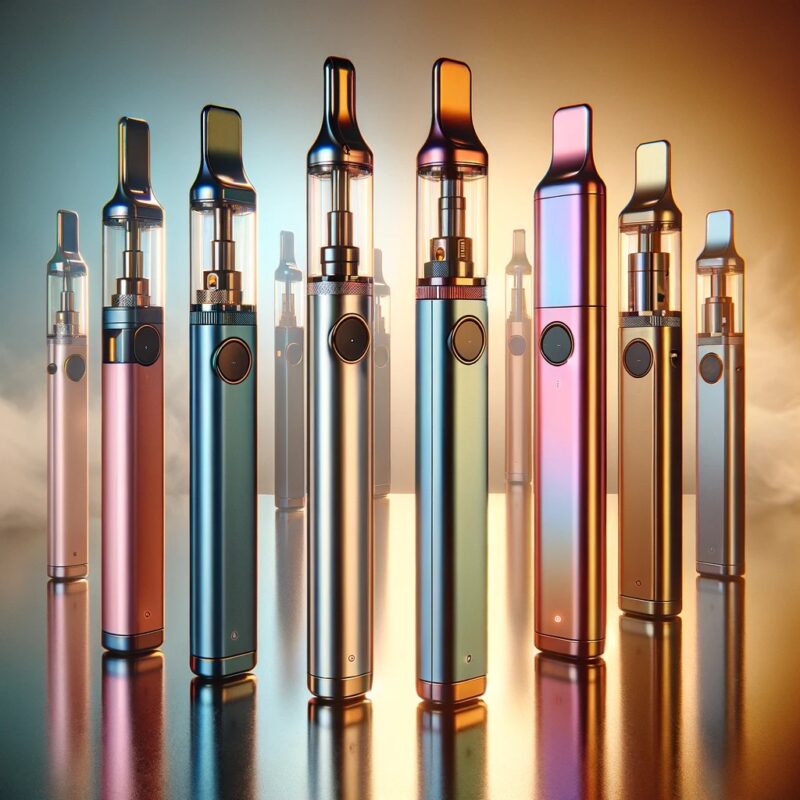The widespread use of vapes, including both e-cigarettes and cannabis vapes, has raised concerns regarding their potential health impacts. Vapes, with their sleek designs and enticing flavours, have gained popularity among both adults and adolescents. However, research suggests that vaping can pose significant risks to respiratory health. The aerosol produced by vapes contains harmful chemicals that can irritate the lungs and lead to respiratory issues, ranging from coughing and shortness of breath to more severe conditions like bronchitis and asthma exacerbation.
The nicotine found in e-cigarettes can have detrimental effects on cardiovascular health, increasing the risk of heart disease and stroke. The addictive nature of nicotine also raises concerns about the potential for long-term dependence and its associated health consequences. Meanwhile, cannabis vapes, often touted as a safer alternative to smoking marijuana, still pose risks due to the potential for exposure to toxic substances such as heavy metals and solvents used in the vaping process.
The lack of regulation in the production and marketing of vapes exacerbates these health concerns. With flavours and packaging designed to appeal to youth, there is a growing fear of a new generation becoming addicted to nicotine and cannabis through vaping. Policymakers need to implement stricter regulations on the manufacturing and advertising of vapes to protect public health, especially among vulnerable populations. Additionally, comprehensive research is needed to fully understand the long-term health impacts of vaping and to develop effective strategies for prevention and cessation.
A Brief History of Vaping and E-Cigarettes
Vapes have revolutionized smoking habits, tracing back to ancient times when herbs were vaporized for therapeutic use. However, the modern history of vapes began in the early 2000s when Chinese pharmacist Hon Lik invented the first commercially successful e-cigarette. These early vapes were rudimentary devices that delivered nicotine in vapor form, offering a potentially less harmful alternative to traditional smoking. Despite skepticism, vapes gained popularity rapidly, with numerous brands and flavors flooding the market.
By the mid-2000s, vapes had become a cultural phenomenon, especially among younger demographics drawn to the sleek designs and customizable features. The widespread adoption of vapes sparked debates over their safety and regulation, prompting researchers to delve into their long-term health effects. Despite concerns, vapes continued to evolve, with advanced models offering temperature control and enhanced battery life. However, controversies persisted, fueled by reports of vaping-related illnesses and addiction among youth.
In recent years, vapes have undergone significant scrutiny, with governments worldwide implementing regulations to address public health concerns. Yet, the vaping industry remains robust, catering to both smokers looking to quit and enthusiasts seeking new experiences. Technological advancements have led to the development of pod-based systems and nicotine salt formulations, further diversifying the vaping landscape. Despite the controversies and challenges, vapes continue to reshape smoking culture, leaving a lasting impact on society’s perception of nicotine consumption.
Are E-Cigarettes Safer than Regular Cigarettes?
Vapes, often marketed as a safer alternative to traditional cigarettes, have sparked debates regarding their health implications. Proponents argue that vapes emit fewer harmful chemicals than regular cigarettes, potentially reducing health risks. However, concerns linger over the long-term effects of vaping on respiratory health. Some studies suggest that vapes may still pose significant health hazards, particularly for young users. Despite their growing popularity, vapes’ safety remains a contentious issue among health experts and policymakers alike.
Critics emphasize the lack of long-term research on the safety of vapes compared to traditional cigarettes. While vapes eliminate the combustion process responsible for many harmful toxins in regular cigarettes, they still contain nicotine, which is addictive and can have adverse effects on brain development, especially in adolescents. Moreover, the variety of flavors and marketing strategies targeting younger demographics raise alarms about potential addiction and gateway to smoking conventional cigarettes.
The efficacy of vapes as smoking cessation aids is another aspect of the debate. Some users report successfully quitting smoking by transitioning to vapes, citing reduced cravings and withdrawal symptoms. However, the effectiveness of this method remains uncertain, with conflicting evidence from research studies. Additionally, concerns persist about dual use, where individuals continue smoking regular cigarettes alongside vaping, potentially negating any health benefits.
While vapes may offer a less harmful alternative to traditional cigarettes, their safety profile is still subject to ongoing research and debate. The presence of nicotine and other chemicals in vapes raises concerns about addiction and long-term health effects, especially among young users. Further studies are needed to fully understand the risks and benefits of vapes compared to regular cigarettes, informing regulatory policies and public health interventions.
Potential Dangers and Health Risks of Vaping
Popcorn Lung
A term often associated with a severe lung condition called bronchiolitis obliterans, has garnered attention amid the rising popularity of cannabis vapes. This condition earned its moniker due to its initial discovery among workers in popcorn factories exposed to diacetyl, a flavoring chemical linked to lung damage. The widespread use of cannabis vapes has reignited concerns about similar health risks, as some products contain diacetyl or other harmful compounds. Reports of respiratory issues among individuals using cannabis vapes have raised alarms within public health circles, highlighting the need for rigorous regulation and consumer awareness.
Cannabis vapes have become a popular method for consuming marijuana, prized for their convenience and discretion. However, the lack of stringent oversight has led to the proliferation of potentially hazardous products in the market. Concerns about “popcorn lung” and other respiratory ailments have prompted calls for greater scrutiny and regulation of cannabis vape ingredients and manufacturing processes. As more cases of lung injuries surface, experts urge caution and advocate for thorough product testing and labeling standards to protect consumers from harm.
In recent years, the debate over the safety of cannabis vapes has intensified, with health authorities issuing warnings about the potential risks associated with these products. Despite efforts to address concerns, reports of lung injuries continue to emerge, underscoring the need for comprehensive measures to safeguard public health. The term “popcorn lung” has become a poignant reminder of the dangers posed by unregulated substances in vaping products, urging policymakers and industry stakeholders to prioritize the well-being of consumers over profits. As the discourse surrounding cannabis vapes evolves, proactive measures are essential to mitigate health hazards and promote responsible usage practices.
The link between “popcorn lung” and cannabis vapes underscores the complex challenges facing the burgeoning cannabis industry. While legalization has paved the way for expanded access to marijuana products, it has also raised important questions about product safety and regulation. As consumers increasingly turn to cannabis vapes, it is imperative to address concerns about potential health risks and ensure that adequate safeguards are in place. By fostering transparency and accountability throughout the supply chain, stakeholders can work together to minimize the threat of lung injuries and build trust in the burgeoning cannabis market.
Lung Damage from Metal Particles
The metal coils used to heat up e-liquids can break down over time and small particles may enter the vapor and be inhaled into lungs. Studies found metals like nickel, chromium, and manganese in many e-cigarette aerosols.
Inhaling these metal particles can lead to lung inflammation, wheezing, and reduced lung function according to animal studies. One experiment found metal concentrations in the lungs of vapers were 3 times higher than in nonsmokers.
Nicotine Addiction and Brain Development
The highly addictive nature of nicotine is a major health concern, especially for teenagers and young adults whose brains are still developing.
Studies show adolescents can become dependent on nicotine very quickly with just minimal exposure. Getting addicted young makes quitting much harder and affects memory, concentration, learning, impulse control, mood, and brain development.
Young people who use e-cigarettes are also much more likely to go on to become cigarette smokers later in life.
The Vaping Illness Outbreak and Lung Injuries
In 2019, a severe outbreak of vaping-related lung illnesses swept across the U.S. As of February 2020, the CDC reported 2,807 hospitalized cases and 68 confirmed deaths affecting 29 states and D.C.
Patients experienced symptoms like:
- Cough, chest pain, shortness of breath
- Nausea, vomiting, diarrhea
- Fatigue, fever, abdominal pain
The CDC’s investigation found that the majority of patients had a history of using cannabis vaping products, particularly those purchased off the street or from informal sources like friends.
The main culprit turned out to be vitamin E acetate, an additive used to thicken vape juice. When inhaled it can stick to lung tissue and cause damage. It was found in samples from afflicted patients.
This outbreak highlighted the risks of black market and bootleg vape cartridges that evade regulation. Legal cannabis vapes that have been tested for safety did not appear connected to the illnesses.
While the acute lung disease outbreak has waned, it demonstrated the potential harm improperly formulated vape liquids can unleash on lung health.
Are There Cancer Risks from Vaping?
Given the relatively recent rise of vaping, long-term studies on e-cigarettes and cancer risks do not yet exist. However, there are some concerning early clues:
- In laboratory tests, vaping causes DNA damage to oral cells in a similar manner to tobacco smoke. Mutations in tumor suppressor genes were also found.
- Carcinogens like formaldehyde and acetaldehyde have been detected in the vapor of some e-cig models. These chemicals are known to cause cancer.
- One study found e-cigarette vapor was just as toxic to lung epithelial cells as cigarette smoke. Toxicity was worse when flavorings were added.
- A different experiment exposed mice to e-cig aerosol for 54 weeks. Some developed malignant lung and bladder tumors.
More research is urgently needed to clarify cancer risk as vaping usage increases. But the presence of DNA-damaging compounds in vapor raises alarms about potential long-term dangers similar to smoking.
Cardiovascular Effects of Vaping
While the risks of vaping on the lungs get more attention, nicotine’s impacts on the cardiovascular system are also a major concern.
Nicotine causes arteries and veins to constrict, increasing blood pressure. Heart rate also rises by around 10 beats per minute after vaping. These cardiovascular effects mirror the impacts of cigarette smoking in several studies.
Constricted blood vessels increase the likelihood of blood clots forming. Platelet activation also goes up in e-cigarette users, boosting clot risk further. These vascular changes raise the odds of heart attack and stroke.
One study found that e-cigarette use doubled the risk of heart attack. Dual users who also smoke cigarettes faced almost 5 times the heart attack risk of non-smokers.
For people at risk of heart disease, vaping nicotine could prove just as dangerous as smoking it. More investigation into cardiovascular impacts is certainly warranted.
Secondhand Vaping – Is It Harmful?
Secondhand smoke from combustible cigarettes is known to be dangerous. But what about breathing in secondhand vapor from e-cigs?
While vape aerosol exposes bystanders to fewer toxins than cigarette smoke, it is not harmless. Testing found exhaled e-cigarette vapor contained nicotine, ultrafine particles, heavy metals, and volatile organic compounds.
One study exposed human lung and bladder cells to secondhand vape. Just like direct vaping, it increased DNA damage and reduced cell survival versus unexposed cells.
Researchers compared the contents of secondhand vape and smoke directly. They estimated e-cig vapor contained about 6 times lower concentrations of toxic compounds than cigarette smoke. Levels of formaldehyde, for example, were 15 times higher in secondhand smoke.
While more benign than secondhand smoke, breathing in secondhand vape still exposes you to some level of toxicants. The effects of exposure long-term remain uncertain. But air vapor likely carries fewer health risks than air contaminated with cigarette smoke.
Is Vaping Addictive?
E-cigarettes have earned a reputation for being very addictive, especially the popular Juul brand which packs a potent nicotine punch. But is vaping as addictive as smoking traditional cigarettes?
Studies investigating nicotine dependence in adult smokers who switch to vaping have found:
- Vapers end up inhaling similar doses of nicotine daily as when they smoked.
- Progression from first use to dependence can be faster with vaping compared to the onset of cigarette addiction.
- Withdrawal symptoms and cravings when quitting vaping mirror what is experienced when quitting smoking.
- The majority of e-cigarette users continue using combustible cigarettes too, known as dual use. This suggests vaping on its own may not satiate nicotine addiction as effectively.
Other concerning research found teens who try vaping are 4 times more likely to start smoking traditional cigarettes within a year compared to teens who never vape.
So while more research is warranted, evidence so far indicates e-cigarettes may be just as dependency-forming as cigarette smoking, if not more so in certain populations like youth. Kicking a vaping habit can be just as difficult as quitting smoking.
Quitting Vaping – How to Stop Juuling and Get Help
Given the emerging health hazards of vaping detailed in this guide, quitting e-cigarettes is recommended. But overcoming nicotine addiction can be extremely challenging. Here are some tips to stop vaping:
- Gradually step down nicotine concentrations in e-juice to wean yourself off chemical dependency before quitting entirely.
- Replace the physical habit of vaping with other oral substitutes like herbal tea, carrot sticks, or chewing gum.
- Avoid triggers that cue the urge to vape like specific places, people, or activities.
- Join online vape quit communities on Facebook or Reddit for support and to share advice.
- Consult your doctor about medications like Zyban, Chantix, nicotine gum, or nicotine patches to ease withdrawal symptoms and cravings.
- Consider counseling or nicotine addiction therapy to identify and modify behavioral patterns keeping you vaping.
- Hypnosis and acupuncture may also complement pharmaceutical and counseling treatments.
Quitting vaping brings risks of irritability, anxiety, depression, insomnia and weight gain in the short term. But you’ll reduce long term health risks and overcome nicotine addiction. Be patient with slip ups and stick with it. Your lungs and cardiovascular system will thank you.
The Bottom Line on Vaping and Health
While vaping may expose users to fewer toxins than traditional cigarette smoke, emerging research clearly indicates it is far from harmless. Vaping negatively impacts lung, heart, and DNA integrity in multiple studies. Its popularity as a safer alternative merits more rigorous investigation into long-term health outcomes.
If you currently vape, take steps to quit sooner than later. If you don’t vape or smoke, don’t start. There are far safer ways to ingest nicotine or cannabis if desired, like patches, edibles, or oral sprays. Always avoid black market vape cartridges.
Vaping has risks, but can potentially serve as a pathway away from combustible cigarette addiction if used cautiously under medical supervision. But given the early red flags around lung and DNA damage, non-nicotine options seem safest until more definitive data emerges. Your lungs will thank you for the fresh air.




